Berberis, Barberry
Lycium (classical name)Xiao Bo (TCM)Daruharidra (Ayurveda)Skyer pa སྐྱེར་པ Skyer shun སྐྱེར་ཤུན –Rasanjana (Ayurveda)Rasaut (Unani)Skyer ba’i khan ta སྐྱེར་པའི་ཁཎྜ Zarishk (fruit, Unani)Skyer ba’i ‘bru སྐྱེར་པའི་འབྲུ
Herbarius latinus , Petri, 1485
Ortus Sanitatis , Cube, Johann von, 1501
New Kreuterbuch , Matthiolus, 1563
B. vulgaris Flora von Deutschland , Kohler, 1886
Members CLICK HERE for the PRO VERSION Botanical name: Berberis spp.
B. vulgaris (standard species of West and Unani) B. asiatica, B. lycium, B. asiatica (Indian Barberry, Ayurveda, Tibet) B. amurensis, B. soulieana (Chinese Barberry, TCM) B. concinna, B. dictophylla (Tibet) B. nepalensis (Nepal) Parts used: 1. Root, Root-Bark
2. Concentrated extract formed by boiling down the root and stems, or whole plant is used. (India, Unani and Tibet)
3. Fruit;
Temperature & Taste: Fruit : Cool, moist when fresh; Cool, dry when dry; Sour
Bark/Extract : Cold, dry. Bitter of thin parts, gently binding
Classification: 2B ATTENUATER. 2F. PURIFYING. 2N. REPELLENTS 3B. FEBRIFUGE & ANTIPYRETIC. 3L. ANTI-TUSSIVE 4b. OPTHALMIC. 4e. STOMACHIC. 4g. HEPATIC TCM:
B. Clears Heat and Damp
Uses: BARBERRY BARK / STEM / EXTRACT 1. Clears Heat and Damp: (West, Unani, Ayurveda, Tibet)
-benefit the Stomach and Liver, promotes Appetite
-good when cooling and binding is needed: Enteritis, Diarrhea, Dysentery etc.
-cholecystitis, Gall stones, Jaundice, Hepatitis
2. Clears Heat and Phlegm, Stops Cough: (West, Unani, Ayurveda, Tibet)
-acute respiratory tract infection; Cough, Bronchitis
3. Clears Heat, Quenches Thirst: (West, Unani, Ayurveda, Tibet)
-Fevers, Malaria, Cholera
-Thirst, Consumption
4. Cools the Blood, Stops Bleeding: (West, Unani, Ayurveda, Tibet)
-Itch, Eczema, Erysipelas
-excess Bleeding from Heat
-“
useful in all types of Bleeding”. (Avicenna) 5. Clears Heat, Resists Poison: (West, Unani, Tibet)
-Poisoning
-Rabies
-Toxic Swellings
-red or painful eyes; mouth sores
6. Kills Worms:
-adjunct for Worms
7. Externally:
i. fruit is used topically to strengthens the gums and fastens the teeth;
ii. a weak infusion makes a good compress for heat and inflammation of the Eyes; used for Conjunctivitis, starting Cataracts and Trachoma. The extract is used in India for Opthalmia and Conjunctivitis
iii. a wash of the bark or root is used externally for Eczema and Neuro-dermatitis.
iv. strong decoction is used topically to promote hair growth
v. Herpes and other skin infections.
vi. “useful in Malignant Ulcers”. (Avicenna)
vii. “
useful in cases of Anal Fissures”. (Avicenna) viii. Ear infections with Pus, and for Ulcers of the Ear
ix. Sores, Inflammations and Ulcers of the Mouth, Palate and Gums (bark, extract)
BARBERRY FRUIT 1. Nourish and Strengthen the Liver
-Liver deficiency
2. Clears Heat, Nourishes Yin
-Fever
2. Astringes to Stop Leakage
-diarrhea
Comment: … available in PRO version .
Dose Decoction of root-bark / stem: 6–12 grams
Powder of the root-bark / stem, or fruit: 1–3 grams
Corrective: … available in PRO version .
Substitute: … available in PRO version .
Main Combinations: Barberry & Tumeric1. Fever; Heat of the Liver, Bladder, Breast, Stomach, combine Barberry
… available in PRO version .
2. Recurring or Daily Fever:
i. Barberry,
… available in PRO version .
ii. Barberry with
… available in PRO version .
3. Bronchitis:
i. Barberry,
… available in PRO version .
ii. Barberry,
… available in PRO version .
4. Biliousness, Barberry with
… available in PRO version .
5. Jaundice:
i. Barberry with
… available in PRO version .
ii. Barberry with
… available in PRO version .
iii. Barberry with
… available in PRO version .
iv. Barberry with
… available in PRO version .
6. Cholecystitis: Barberry with
… available in PRO version .
7. Liver Heat and Gall Bladder disease:
i. Barberry with
… available in PRO version .
ii. Barberry with
… available in PRO version .
iii. Barberry root with
… available in PRO version .
8. Eczema:
i. Barberry,
… available in PRO version .
ii. Barberry,
… available in PRO version .
iii. Barberry,
… available in PRO version .
9. Skin conditions associated with Liver heat, Barberry, Madder,
… available in PRO version .
10. Poor Appetite related to Liver, Barberry with
… available in PRO version .
11. Indigestion:
i. with food sensitivity, Barberry fruit,
… available in PRO version .
ii. with Depression, Barberry fruit,
… available in PRO version .
12. Gastric Ulcer,
… available in PRO version .
13. Dysentery
i. Barberry with
… available in PRO version .
ii. Barberry,
… available in PRO version .
iii. Barberry,
… available in PRO version .
14. Hemorrhoids, Barberry with
… available in PRO version .
15. Gout, excess Uric acid, Barberry bark
… available in PRO version .
16. Excess Menstruation, Uterine Bleeding from Heat:
i. Barberry root
… available in PRO version .
ii. Barberry seed with
… available in PRO version .
17. Acute sore throat, combine Barberry with
… available in PRO version .
18. Influenza, Barberry with
… available in PRO version .
19. Consumption, Barberry with
… available in PRO version .
20. Oil for Skin diseases, Barberry with
… available in PRO version .
Major Formulas Decoction of Dandelion Decoction for Excessive Menstruation Troches of Barberries (Trochisci de Berberis) (Mesue) Troches of Gum Lacca (Trochisci de Lacca) (Mesue) Troches of Spodium (Trochisci Spodii) (Avicenna) Troches of Sandalwoods (Trochisci Santalon) (Mesue) Troches for Hardness of the Liver (Nicholas) Electuary for Quotidian, Tertian and Quartan Fever (Galen) Barberry 8 Powder (Skyer sun brgyad pa) (Tibetan Medicine)Emblic 6 (Kyu ru duk pa) (Tibetan Medicine) Turmeric Decoction 4 (Yung ba 4) (Tibetan Medicine) Chebula 18 for Urinary Incontinence (Gcin snyi a ru 18) (Tibetan Medicine) Possessor of Ruby Color (Pad rag mdog ldan) (Tibetan Medicine)
Cautions: 1. Not used in Cold and weak digestion
2. Generally not used in Pregnancy
Toxicity: Toxic in Overdose. Symptoms may include Gastro-Intestinal upset, Ulceration, Immunotoxicity, Phototoxicity, Neuro-toxicity, Cardiotoxicity and Jaundice.
Main Preparations used: Dried or prepared Fruit, clarified Juice of the Berries, Rob, and Troches were used
‘The medical practitioners of ancient Greece and Italy made use of a substance called Lycium of which the best kind was brought from India. It was regarded as a remedy of great value in restraining inflammatory and other discharges; but of all the uses to which it was applied the most important was the treatment of various forms of ophthalmic inflammation. Lycium is mentioned by Dioscorides, Pliny, Celsus, Galen, and Scribonius Largus ; by such later Greek writers as Paulus Aegineta, Aetius, and Oribasius , as well as by the Arabian physicians. The author of the Periplus of the Erythrean Sea who probably lived in the 1st century, enumerates [Lycium] as one of the exports of Barbarike at the mouth of the Indus , and also names it along with Bdellium and Costus among the commodities brought to Barygaza :— and further, lycium is mentioned among the Indian drugs on which duty was levied at the Roman custom house of Alexandria about A.D. 176—180.’ An interesting proof of the esteem in which it was held is afforded by some singular little vases or jars of which a few specimens are preserved in collections of Greek antiquities. These vases were made to contain lycium , and in them it was probably sold; for an inscription on the vessel not only gives the name of the drug but also.that of a person who, we may presume, was either the seller or the inventor of the composition. Thus we have the Lycium of Jason , of
Musccus, and of Heracleus ). The vases bearing the name of Jason were found at Tarentum , and there is reason to believe that that marked Heradeus was from the same locality. Whether it was so or not, we know that a certain Heraclides of Tarentum is mentioned by Celsus on account of his method of treating certain diseases of the eye; and that Galen gives formula; for ophthalmic medicines on the authority of the same person.lycium , and especially of that highly esteemed kind that was brought from India. In the year 1833, Royle communicated to the Linnean Society of London a paper proving that the Indian Lycium of the ancients was identical with an extract prepared from the wood or root of several species of Berberis growing in Northern India, and that this extract, well known in the bazaars as Rusot or Rasot , was in common use among the natives in various forms of eye disease. This substance attracted considerable notice in India, and though its efficacy per se1 seemed questionable, it was administered with benefit as a tonic and febrifuge. But the rasot of the natives being often badly prepared or adulterated, the bark of the root has of late been used in its place, and in consequence of its acknowledged efficacy has been admitted to the Pharmacopoeia of India. ( Pharmacographia , Fluckiger & Hanbury, 1879)
NOTE: The following research is for varioius different species of Berberis, the majority being the above-named medicinal species. Most refer to the use of the stem/ bark, but some are for the fruit. Note also that some indications including Diabetes and Cancer, are well represented by a number of species.
GENERAL / REVIEWMedicinal Species of the Genus Berberis: A Review of Their Traditional and Ethnomedicinal Uses, Phytochemistry and Pharmacology. Ethnomedicinal uses, Phytochemistry and Pharmacological Aspects of the Genus Berberis Linn: A Comprehensive Review. Berberine and barberry (Berberis vulgaris): A clinical review. Berberis vulgaris : specifications and traditional uses. Berberis Vulgaris and Berberine: An Update Review. The berberis story: Berberis vulgaris in therapeutics. A quick overview on some aspects of endocrinological and therapeutic effects of Berberis vulgaris L. A review on biological and chemical diversity in Berberis (Berberidaceae). Phytochemistry and pharmacology of berberis species. Phyto-chemical and pharmacological applications of Berberis aristata. A pharmacological study on Berberis vulgaris fruit extract. [The use of barberry berries in human nutrition]. Biological properties and clinical applications of berberine. Antioxidant, Antimicrobial Activities and Fatty Acid Compositions of Wild Berberis spp. by Different Techniques Combined with Chemometrics (PCA and HCA). Phytochemical screening, antimicrobial activity, in vitro and in vivo antioxidant activity of Berberis lycium Royle root bark extract. Antioxidant, Antimicrobial Activities and Fatty Acid Compositions of Wild Berberis spp. by Different Techniques Combined with Chemometrics (PCA and HCA). Chemical composition and antibacterial activity of Berberis vulgaris (barberry) against bacteria associated with caries. The antibacterial activity of Berberis heteropoda Schrenk and its effect on irritable bowel syndrome in rats. Quality Control Standardization and Evaluation of Antimicrobial Potential of Daruhaldi (Berberis aristata DC) Stem Bark. Antimicrobial activities of Indian Berberis species. Antimicrobial activity of four species of Berberidaceae. Antimicrobial activity of crude extracts from berberis asiatica stem bark. Antifungal, Antileishmanial, and Cytotoxicity Activities of Various Extracts of Berberis vulgaris (Berberidaceae) and Its Active Principle Berberine. Activity of Berberis aetnensis root extracts on Candida strains. Anti-influenza activity of berberine improves prognosis by reducing viral replication in mice. Identification of Berbamine, Oxyacanthine and Rutin from Berberis asiatica as anti-SARS-CoV-2 compounds: An in silico study. Rapid determination and optimisation of berberine from Himalayan Berberis lycium by soxhlet apparatus using CCD-RSM and its quality control as a potential candidate for COVID-19. Berbamine ameliorates ethanol-induced liver injury by inhibition of hepatic inflammation in mice. Hepatoprotective effects of Berberis vulgaris leaf extract on carbon tetrachloride-induced hepatotoxicity in rats. Berberis vulgaris L. effects on oxidative stress and liver injury in lead-intoxicated mice. Hepatoprotective effects of Berberis vulgaris L. extract/β cyclodextrin on carbon tetrachloride-induced acute toxicity in mice. Berberis lyceum and Fumaria indica : in vitro cytotoxicity, antioxidant activity, and in silico screening of their selected phytochemicals as novel hepatitis C virus nonstructural protein 5A inhibitors. The effect of berberis vulgaris extract on transaminase activities in non-alcoholic Fatty liver disease. The effect of hydroalcoholic Berberis integerrima fruits extract on the lipid profile, antioxidant parameters and liver and kidney function tests in patients with nonalcoholic fatty liver disease. Antinociceptive and Anti-Inflammatory Like Effects of Berberis baluchistanica. Anti-Inflammatory and Immunomodulatory Effects of Barberry (Berberis vulgaris ) and Its Main Compounds. ANTI-INFLAMMATORY, ANALGESIC AND ANTIPYRETIC ACTIVITIES OF THE AQUEOUS METHANOLIC EXTRACT OF BERBERIS CALLIOBOTRYS IN ALBINO MICE. Anti-inflammatory and anti-granuloma activity of Berberis aristata DC. in experimental models of inflammation. Study on the anti-inflammatory action of Berberis vulgaris root extract, alkaloid fractions and pure alkaloids. Analgesic and neuropharmacological activities of Berberis lycium Royle collected from district Sherani Balochistan, Pakistan. A review on pain-relieving activity of berberine. ANTI-INFLAMMATORY, ANALGESIC AND ANTIPYRETIC ACTIVITIES OF THE AQUEOUS METHANOLIC EXTRACT OF BERBERIS CALLIOBOTRYS IN ALBINO MICE. Berberis vulgaris and its constituent berberine as antidotes and protective agents against natural or chemical toxicities. Berberine mitigates oxidative damage associated with testicular impairment following mercury chloride intoxication. Anti-Inflammatory and Immunomodulatory Effects of Barberry (Berberis vulgaris ) and Its Main Compounds. Investigation of the Immunomodulatory effect of Berberis vulgaris on core-pulsed dendritic cell vaccine. Evaluation of the effects of additional therapy with Berberis vulgaris oxymel in patients with refractory primary sclerosing cholangitis and primary biliary cholangitis: A quasi-experimental study. Berberis vulgaris for cardiovascular disorders: a scoping literature review. The effect of purple-black barberry (Berberis integerrima) on blood pressure in subjects with cardiovascular risk factors: a randomized controlled trial. Berberine for the treatment of hypertension: A systematic review. The effect of barberry (Berberis vulgaris) consumption on flow-mediated dilation and inflammatory biomarkers in patients with hypertension: A randomized controlled trial. Effect of barberry (Berberis vulgaris) consumption on blood pressure, plasma lipids, and inflammation in patients with hypertension and other cardiovascular risk factors: study protocol for a randomized clinical trial. The effect of barberry (Berberis vulgaris L.) supplementation on blood pressure: A systematic review and meta-analysis of the randomized controlled trials. Alterations of Blood Pressure and ECG following Two-Week Consumption of Berberis integerrima Fruit Extract. The antihypertensive and vasodilator effects of aqueous extract from Berberis vulgaris fruit on hypertensive rats. Barberry (Berberis vulgaris L.) is a safe approach for management of lipid parameters: A systematic review and meta-analysis of randomized controlled trials. Clinical role of a fixed combination of standardized Berberis aristata and Silybum marianum extracts in diabetic and hypercholesterolemic patients intolerant to statins. Antihyperglycemic and Antihyperlipidemic Effects of Fruit Aqueous Extract of Berberis integerrima Bge. in Streptozotocin-induced Diabetic Rats. Berberis aristata combined with Silybum marianum on lipid profile in patients not tolerating statins at high doses. Gastroprotective effect of Berberis vulgaris on ethanol-induced gastric mucosal injury: Histopathological evaluations. Histopathological evaluation of gastro protective effect of Berberis vulgaris (Zereshk) seeds against aspirin induced ulcer in albino mice. Role of a berberine-based nutritional supplement in reducing diarrhea in subjects with functional gastrointestinal disorders. Effects of berberine in the gastrointestinal tract – a review of actions and therapeutic implications. Berberine Administration in Treatment of Colitis: A Review. Berberis lycium fruit extract attenuates oxi-inflammatory stress and promotes mucosal healing by mitigating NF-κB/c-Jun/MAPKs signalling and augmenting splenic Treg proliferation in a murine model of dextran sulphate sodium-induced ulcerative colitis. Berberine Regulates Treg/Th17 Balance to Treat Ulcerative Colitis Through Modulating the Gut Microbiota in the Colon. The antibacterial activity of Berberis heteropoda Schrenk and its effect on irritable bowel syndrome in rats. Effect of water extract from Berberis heteropoda Schrenk roots on diarrhea-predominant irritable bowel syndrome by adjusting intestinal flora. Aqueous extract of dried fruit of Berberis vulgaris L. in acne vulgaris, a clinical trial. Antipsoriatic and Anti-inflammatory Studies of Berberis aristata Extract Loaded Nanovesicular Gels. Reno Protective Role Of N Acetyl Cysteine And Aqueous Extract Of Berberis Lycium Royale Root Bark On Rats. Berberis vulgaris root bark extract prevents hyperoxaluria induced urolithiasis in rats. The effects of Berberis vulgaris L. and Berberis aristata L. in metabolic syndrome patients: a systematic and meta-analysis study. Barberry in the treatment of obesity and metabolic syndrome: possible mechanisms of action. A review of the effects of Berberis vulgaris and its major component, berberine, in metabolic syndrome. Berberine: New Insights from Pharmacological Aspects to Clinical Evidences in the Management of Metabolic Disorders. The effect of barberry (Berberis vulgaris L.) on glycemic indices: A systematic review and meta-analysis of randomized controlled trials. The Effects of Berberis integerrima Fruit Extract on Glycemic Control Parameters in Patients with Type 2 Diabetes Mellitus: A Randomized Controlled Clinical Trial. Phytopharmacology and Clinical Updates of Berberis Species Against Diabetes and Other Metabolic Diseases. Berberis kansuensis extract alleviates type 2 diabetes in rats by regulating gut microbiota composition. Berberis lycium Royle. extracts attenuate inflammation and modulates hyperglycemia in alloxan induced diabetic rats. [Quality evaluation of different Berberidis Cortex species based on ~1H-NMR metabolomics and anti-diabetic activity]. Berberine alleviates type 2 diabetic symptoms by altering gut microbiota and reducing aromatic amino acids.
–Anti-Diabetic Effects of Berberis kansuensis Extract on Type 2 Diabetic Rats Revealed by 1 H-NMR-Based Metabolomics and Biochemistry Analysis. 1H NMR-Based Metabolomics Coupled With Molecular Docking Reveal the Anti-Diabetic Effects and Potential Active Components of Berberis vernae on Type 2 Diabetic Rats. Safety and efficacy of Berberis integerrima root extract in patients with type 2 diabetes. A parallel intervention based triple blind clinical trial. Antidiabetic Effect of Methanolic Extract from Berberis julianae Schneid. via Activation of AMP-Activated Protein Kinase in Type 2 Diabetic Mice. Berberis Fruit Extract and Biochemical Parameters in Patients With Type II Diabetes. Amelioration of diabetic retinopathy in db/db mice by treatment with different proportional three active ingredients from Tibetan medicine Berberis dictyophylla F. Protective effect of Berberis vulgaris fruit extract against Paraquat-induced pulmonary fibrosis in rats. Anti-Hyperuricemic and Uricosuric Potential of Berberis vulgaris in Oxonate-Induced Hyperuricemic Rats. Berberis lycium fruit extract and its phytoconstituents berberine and rutin mitigate collagen-CFA-induced arthritis (CIA) via improving GSK3β/STAT/Akt/MAPKs/NF-κB signaling axis mediated oxi-inflammation and joint articular damage in murine model. Anti-arthritic activity of aqueous-methanolic extract and various fractions of Berberis orthobotrys Bien ex Aitch. Berberis aristata Ameliorates Adjuvant-Induced Arthritis by Inhibition of NF-κB and Activating Nuclear Factor-E2-related Factor 2/hem Oxygenase (HO)-1 Signaling Pathway. The effect of black barberry hydroalcoholic extract on immune mediators in patients with active rheumatoid arthritis: A randomized, double-blind, controlled clinical trial. Berberine Inhibits the Gene Expression and Production of Proinflammatory Cytokines by Mononuclear Cells in Rheumatoid Arthritis and Healthy Individuals. Effects of hydroalcoholic extract of Berberis Integerrima on the anthropometric indices and metabolic profile in active rheumatoid arthritis patients. Berberine for bone regeneration: Therapeutic potential and molecular mechanisms. Anti-osteoporotic activity of aqueous-methanol extract of Berberis aristata in ovariectomized rats. Protective Effects of Berberis vulgaris on Diazinon-Induced Brain Damage in Young Male Mice. Neuroprotective effects of berberine in animal models of Alzheimer’s disease: a systematic review of pre-clinical studies. Berberine was neuroprotective against an in vitro model of brain ischemia: survival and apoptosis pathways involved. The Evaluation of Pro-Cognitive and Antiamnestic Properties of Berberine and Magnoflorine Isolated from Barberry Species by Centrifugal Partition Chromatography (CPC), in Relation to QSAR Modelling. Analgesic and neuropharmacological activities of Berberis lycium Royle collected from district Sherani Balochistan, Pakistan. Analgesic and neuropharmacological activities of Berberis lycium Royle collected from district Sherani Balochistan, Pakistan. Berberine and neurodegeneration: A review of literature. Neuroprotective effects of berberine in animal models of Alzheimer’s disease: a systematic review of pre-clinical studies. Isoquinoline Alkaloids from Berberis vulgaris as Potential Lead Compounds for the Treatment of Alzheimer’s Disease. Berberis aetnensis and B. libanotica: a comparative study on the chemical composition, inhibitory effect on key enzymes linked to Alzheimer’s disease and antioxidant activity. The therapeutic potential of Berberis darwinii stem-bark: quantification of berberine and in vitro evidence for Alzheimer’s disease therapy. Treatment of Parkinson’s disease in Zebrafish model with a berberine derivative capable of crossing blood brain barrier, targeting mitochondria, and convenient for bioimaging experiments. The effects of Berberis vulgaris L. root extract on the opiate withdrawal syndrome and psychological factors: a randomized double-blind clinical trial. Effect of hydroalcoholic extract of Berberis integerrima and resveratrol on ovarian morphology and biochemical parameters in Letrozole-induced polycystic ovary syndrome rat model: An experimental study. The Effects of Berberis Vulgaris Juice on Insulin Indices in Women with Benign Breast Disease: A Randomized Controlled Clinical Trial. Potential benefits of berberine in the management of perimenopausal syndrome. Activity of isoflavones and berberine on vasomotor symptoms and lipid profile in menopausal women. Oral administration of berberine represses macrophage activation-associated benign prostatic hyperplasia: a pivotal involvement of the NF-κB. Berberis aristata Ameliorates Testicular Toxicity Induced by Combination of First-Line Tuberculosis Drugs (Rifampicin + Isoniazid + Pyrazinamide) in Normal Wistar Rats. Beneficial Effect of Berberis amurensis Rupr. on Penile Erection. Regulation of Cell-Signaling Pathways by Berbamine in Different Cancers. Natural Products as Anticancer Agents. Berberine: A novel therapeutic strategy for cancer. Cytotoxic and Proapoptotic Activity of Sanguinarine, Berberine, and Extracts of Chelidonium majus L. and Berberis thunbergii DC. toward Hematopoietic Cancer Cell Lines. Anticancer effect of berberine based on experimental animal models of various cancers: a systematic review and meta-analysis. Berberis orthobotrys – A promising herbal anti-tumorigenic candidate for the treatment of pediatric alveolar rhabdomyosarcoma. In vitro biological assessment of Berberis vulgaris and its active constituent, berberine: antioxidants, anti-acetylcholinesterase, anti-diabetic and anticancer effects. Berbamine Suppresses the Progression of Bladder Cancer by Modulating the ROS/NF-κ B Axis. Antitumor Effects of Berberine on Gliomas via Inactivation of Caspase-1-Mediated IL-1β and IL-18 Release. Palmatine, a Bioactive Protoberberine Alkaloid Isolated from Berberis cretica , Inhibits the Growth of Human Estrogen Receptor-Positive Breast Cancer Cells and Acts Synergistically and Additively with Doxorubicin. Studies on the Dual Cytotoxicity and Antioxidant Properties of Berberis vulgaris Extracts and Its Main Constituent Berberine. Ethanolic Extract of Berberis Vulgaris Fruits Inhibits the Proliferation of MCF-7 Breast Cancer Cell Line Through Induction of Apoptosis. Berberine in combination with cisplatin suppresses breast cancer cell growth through induction of DNA breaks and caspase-3-dependent apoptosis. The antioxidant and chemical properties of Berberis vulgaris and its cytotoxic effect on human breast carcinoma cells. Targeting Aberrant Expression of STAT3 and AP-1 Oncogenic Transcription Factors and HPV Oncoproteins in Cervical Cancer by Berberis aquifolium A Combined Treatment with Berberine and Andrographis Exhibits Enhanced Anti-Cancer Activity through Suppression of DNA Replication in Colorectal Cancer. Berberine Promotes Apoptosis of Colorectal Cancer via Regulation of the Long Non-Coding RNA (lncRNA) Cancer Susceptibility Candidate 2 (CASC2)/AU-Binding Factor 1 (AUF1)/B-Cell CLL/Lymphoma 2 (Bcl-2) Axis. Chemotherapeutic effect of Berberis integerrima hydroalcoholic extract on colon cancer development in the 1,2-dimethyl hydrazine rat model. BERBERIS VULGARIS FRUIT CRUDE EXTRACT AS A NOVEL ANTI-LEUKAEMIC AGENT. Berbamine derivatives: a novel class of compounds for anti-leukemia activity. Berbamine: a novel inhibitor of bcr/abl fusion gene with potent anti-leukemia activity. Effect of berbamine on invasion and metastasis of human liver cancer SMMC-7721 cells and its possible mechanism. In Vitro Anticancer Potential of Berberis lycium Royle Extracts against Human Hepatocarcinoma (HepG2) Cells. Isolation of Oxyberberine and β -Sitosterol from Berberis lycium Royle Root Bark Extract and In Vitro Cytotoxicity against Liver and Lung Cancer Cell Lines. Berbamine Inhibits Cell Proliferation and Migration and Induces Cell Death of Lung Cancer Cells via Regulating c-Maf, PI3K/Akt, and MDM2-P53 Pathways. Isolation of Oxyberberine and β -Sitosterol from Berberis lycium Royle Root Bark Extract and In Vitro Cytotoxicity against Liver and Lung Cancer Cell Lines. Berberine chloride suppresses non-small cell lung cancer by deregulating Sin3A/TOP2B pathway in vitro and in vivo. Anti – tumour effect of berberis asiatica roxb. Ex. Dc. On dalton’s lymphoma ascite. Identification of berberine as a novel drug for the treatment of multiple myeloma via targeting UHRF1. Berbamine suppresses cell proliferation and promotes apoptosis in ovarian cancer partially via the inhibition of Wnt/β-catenin signaling. Berberis libanotica Ehrenb extract shows anti-neoplastic effects on prostate cancer stem/progenitor cells. Berberine inhibits human tongue squamous carcinoma cancer tumor growth in a murine xenograft model. Berberis integerrima hydro-alcoholic root extract ant its constituent berberine protect against cisplatin-induced nephro- and hepato-toxicity. Effect of Berberis vulgaris L. root extract on ifosfamide-induced in vivo toxicity and in vitro cytotoxicity. Quantification of Berberine in Berberis vulgaris L. Root Extract and Its Curative and Prophylactic Role in Cisplatin-Induced In Vivo Toxicity and In Vitro Cytotoxicity. Wound healing activity of root extracts of Berberis lyceum royle in rats. Plant medicines of Indian origin for wound healing activity: a review.

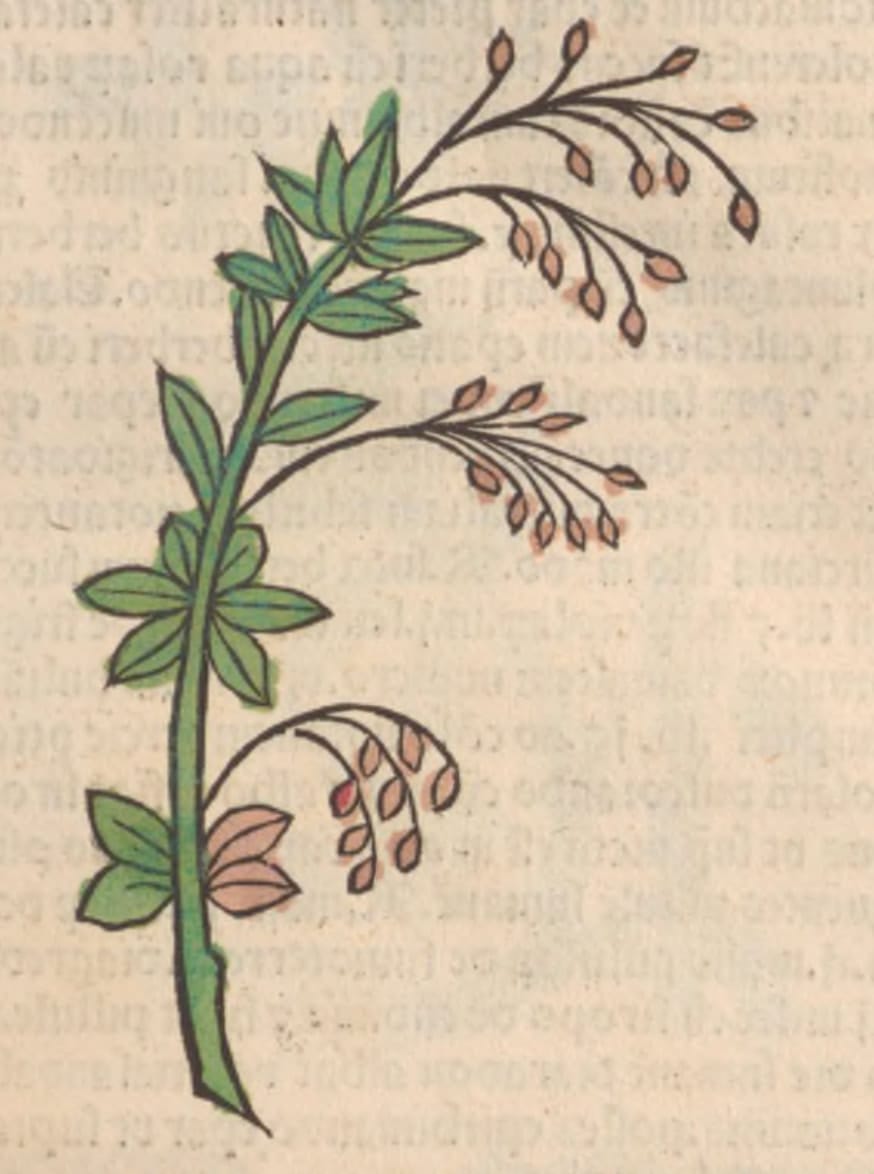 Herbarius latinus, Petri, 1485
Herbarius latinus, Petri, 1485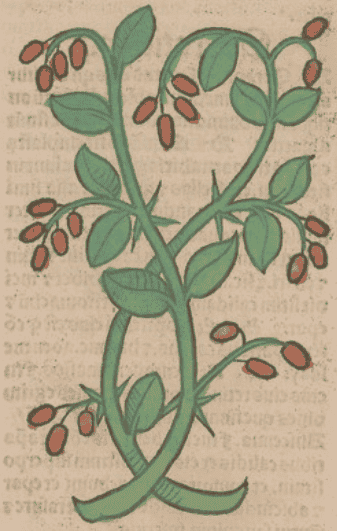 Ortus Sanitatis, Cube, Johann von, 1501
Ortus Sanitatis, Cube, Johann von, 1501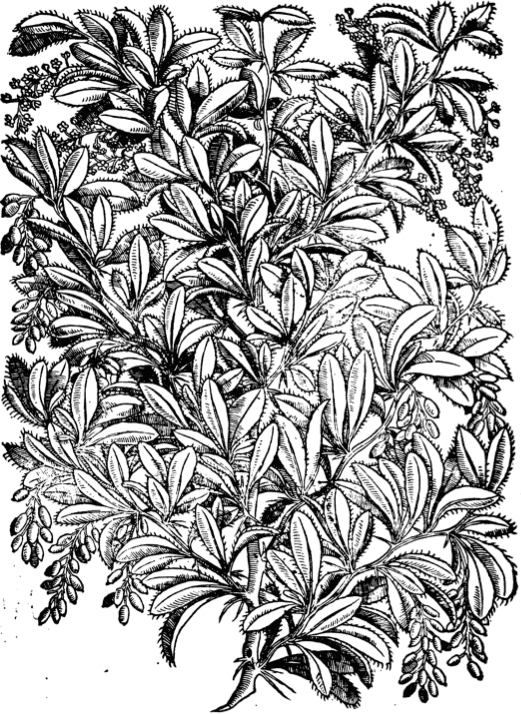 New Kreuterbuch, Matthiolus, 1563
New Kreuterbuch, Matthiolus, 1563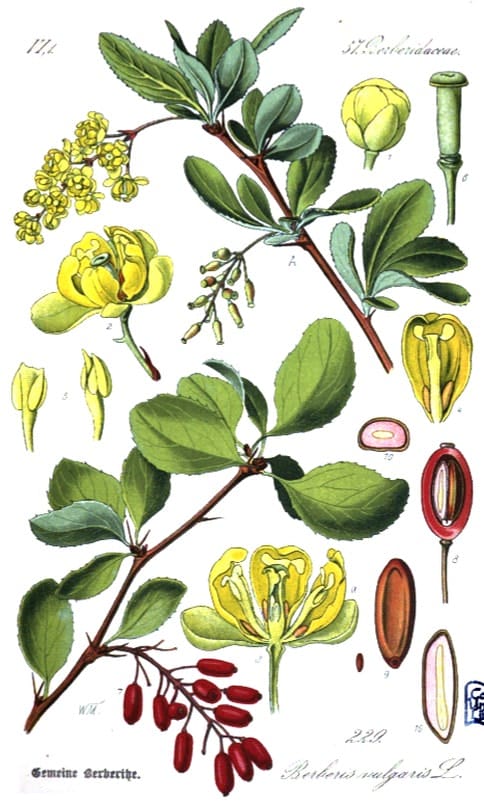 B. vulgaris
B. vulgaris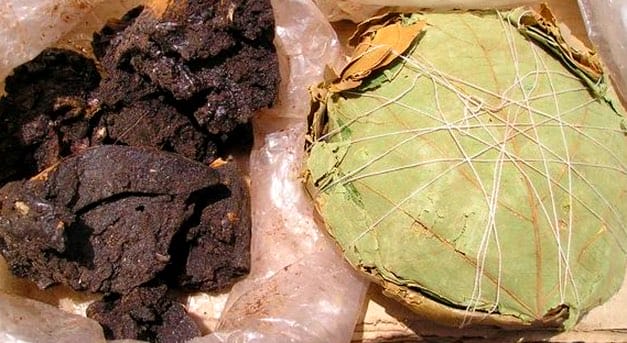 Barberry extract as available on the Indian Market (Adam, 2006)
Barberry extract as available on the Indian Market (Adam, 2006)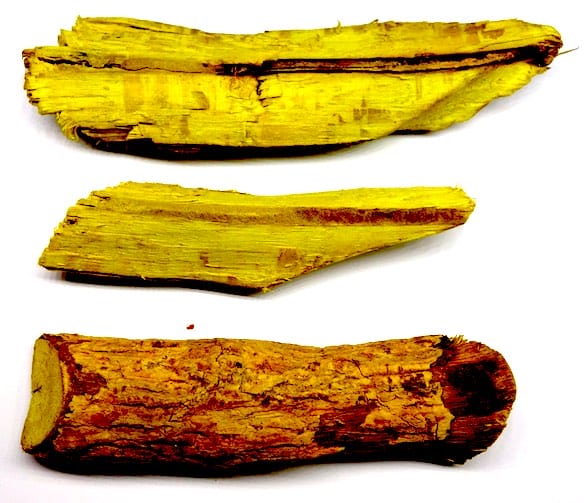 Barberry Wood (Adam, 2019)
Barberry Wood (Adam, 2019) Members CLICK HERE for the PRO VERSION
Members CLICK HERE for the PRO VERSION
